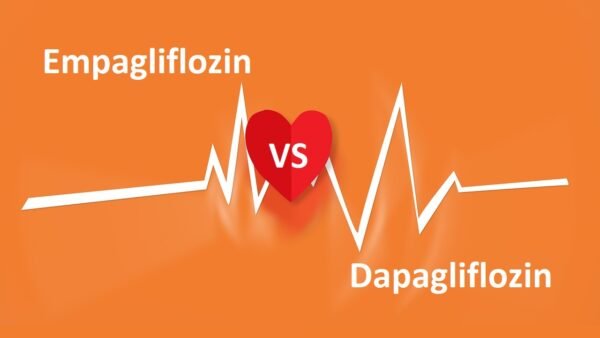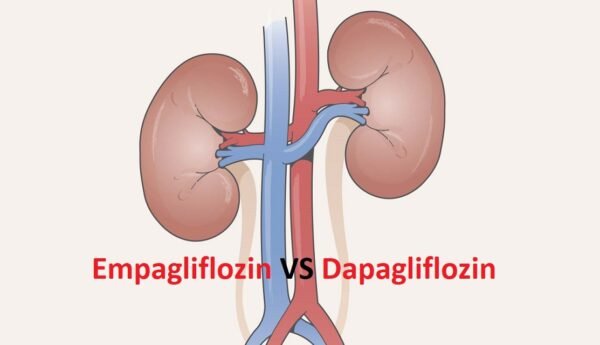"Empagliflozin Vs Dapagliflozin (Jardiance vs Farxiga)" outlines the major differences and similarities between the two commonly prescribed SGLT2 inhibitors.
It is important to note that studies are being conducted and that pharmaceutical companies' sponsorships may result in a bias factor in these research articles. This article is not sponsored by any pharmaceutical company and is totally a personal opinion.
Empagliflozin Vs Dapagliflozin - (Jardiance vs Farxiga):

-
Mechanism of action:
Both drugs act by inhibiting the sodium-glucose cotransporters in the proximal tubules of the kidneys. This results in the excretion of most of the glucose that has been filtered into the renal tubules.
Excessive glucose excretion in the urine causes a direct reduction in serum glucose. The loss of excess glucose causes a caloric loss resulting in a weight-losing effect.
The excretion of glucose in the urine is also accompanied by water loss that may have a diuretic and a blood pressure-lowering effect.
-
Dosing formulations:
Both drugs are available in oral tablet formulations that may be administered once or twice daily.
Both drugs are also available in combination with metformin.
Dapagliflozin (Farxiga) and metformin combination are available by the brand name of Xigduo XR. Empagliflozin in combination with metformin is available by the brand name Synjardy.
Empagliflozin is also available in a triple combination with linagliptin (Tradjenta) and metformin by the brand name TriJardy XR.
-
Bioavailability:
- Dapagliflozin has a bioavailability of 78%
- Empagliflozin has a bioavailability of 78%
-
Time to peak concentration:
- Dapagliflozin reaches peak plasma concentration in about 2 hours
- Empagliflozin reaches peak plasma concentration in about 1.5 hours
-
Half-life elimination:
- The half-life elimination of Dapagliflozin is about 12.9 hours.
- The half-life elimination of Dapagliflozin is about 12.4 hours.
-
Major adverse drug reactions:
The most common adverse effect of both drugs is a urogenital infection.
Both drugs can elevate plasma lipid levels and increase the risk of osteoporosis and fractures.
Euglycemic ketoacidosis and necrotizing fasciitis are among the serious complications.
-
Empagliflozin vs dapagliflozin - weight loss comparison:

Although all SGLT2 inhibitors cause the urinary excretion of glucose resulting in the loss of calories. This has a greater weight loss effect compared to other anti-diabetic medications.
Studies have documented a weight loss ranging from 4 - 10 kgs over 6 months to one year with the use of SGLT2 inhibitors.
In one study, Dapagliflozin was shown to have long-lasting weight-reducing effects compared to empagliflozin. Empagliflozin was shown to have a weight-reducing effect that lasted only for the first three months [Ref].
Also, see Empagliflozin (Jardiance) for Weight Loss in Non-Diabetic Patients!
-
Empagliflozin vs dapagliflozin - Use in Diabetes Type-1:
SGLT2 inhibitors have been increasingly studied in patients with diabetes mellitus type 1 because of their insulin-independent mechanism of action.
The EASE Trials evaluated the role of empagliflozin in patients with diabetes mellitus type 1.
Empagliflozin was used in dosage strengths of 2.5 mg, 10 mg, and 25 mg. Patients had a significant improvement in glycated hemoglobin (about 0.5% at 26 weeks) and a reduction in the weight of about 3 kgs.
A significant improvement was noted even in patients who used empagliflozin in lower doses (2.5 mg daily).
The DEPICT Trials evaluated the role of dapagliflozin in patients with diabetes mellitus type 1.
Similar to the EASE trial, the DEPICT Trials showed significant improvements in the glycated hemoglobin (about 0.4% at week 52) and a reduction in weight of about 3 kgs occurred compared to the placebo.
Farxiga (dapagliflozin) has been approved for use in patients with diabetes mellitus type 1 by the NICE (National Institute of Clinical Excellence).
The use of Jardiance in patients with Diabetes Mellitus Type 1, however, has been refused approval by the FDA.
The risk of euglycemic ketoacidosis is the major serious adverse effect that resulted in the drug's disapproval for use in T1DM patients.
However, physicians are using these drugs off-label in patients with T1DM because of their clear benefits in improving cardiovascular morbidity and mortality, reducing the incidence of heart failure, and halting disease progression in patients with diabetic nephropathy.
It is also important that patients should be carefully selected when advising SGLT2 inhibitors. Patients who are obese with a BMI of 27 Kg/m² or more, those who require insulin at doses greater than 0.5 units/kg, and those who have not had a recent episode of diabetic ketoacidosis may be the best candidates for using SGLT2 inhibitors.
-
Empagliflozin vs dapagliflozin - Use in patients with heart failure:

Both drugs have an established cardioprotective role. The statistical differences exist because of the patient's selection.
For example, patients in the empagliflozin group had a greater reduction in the eGFR compared to dapagliflozin (less than 45% in the empagliflozin group compared to less than 60% in the dapagliflozin group).
Another explanation for the differences in cardiovascular outcomes could be due to the receptor selectivity and the duration of the effects. Dapagliflozin has longer-lasting sodium and glucose excretion effects resulting in sustained osmotic diuresis.
Empagliflozin has more receptor selectivity. It has a 2500-fold selectivity for SGLT2 compared to SGLT-1. On the other hand, Dapagliflozin has a 1200-fold selectivity for SGLT2 than SGLT1 receptors. SGLT1 receptors are present in the intestine and may better control post-prandial glycemia compared to empagliflozin.
SGLT1 inhibitors are also thought to be present in the cardiac myocytes, however, this is yet to be confirmed. SGLT1 inhibition in the cardiac myocytes might be directly inhibiting cardiac remodeling.
Specifically, SGLT-2 inhibitors reduce the incidence of heart failure and hospitalization due to heart failure and left ventricular failure.
Dapagliflozin improves the cardiometabolic parameters, vascular remodeling, and left ventricular diastolic function.
Empagliflozin improves the left ventricular function and diastolic mass in patients with diabetes mellitus type 2.
- Dapagliflozin:
- The DECLARE-TIMI 58 Trials demonstrated a 27% reduction in heart failure in the dapagliflozin group compared to placebo.
- The incidence rates of cardiovascular events in patients who were newly receiving dapagliflozin and empagliflozin were 12.3 and 16.3 per 1000 person-years [Ref]
- Empagliflozin:
- In the EMPAREG-Outcome trial, a 14% reduction in the composite cardiovascular event was noted. Compared to placebo, there was a 35% reduction in heart failure compared to placebo.
-
Empagliflozin vs dapagliflozin - Use in patients with kidney disease:

SGLT2 inhibitors halt the deterioration in renal failure compared to placebo. The renoprotective effects of this class of drugs could be due to a reduction in glomerular pressure, a reduction in hyperfiltration, and a decrease in intravascular volume.
Apart from these direct effects, a reduction in glycated end-products could be another reason indirectly affecting kidney function.
- Dapagliflozin vs empagliflozin:
Dapagliflozin has been shown to have a superior reno-protective role compared to empagliflozin.
Compared to empagliflozin, a reduction in the eGFR over time was less in the dapagliflozin group. However, it is important to note that patients in the empagliflozin group had more advanced kidney disease at baseline compared to those in the dapagliflozin group.
Once a decline in kidney function starts, there are more chances of progression and deterioration in renal functions. This could have skewed the results in favor of dapagliflozin since these patients had better kidney function at baseline as shown here:
Other studies have demonstrated a greater reduction in urinary microalbumin excretion with empagliflozin compared to dapagliflozin [Ref].
-
Empagliflozin vs dapagliflozin - Use in patients with fatty liver:
SGLT2 inhibitors alone or in combination with GLP-1 receptors agonists have been shown to improve histology, biochemical parameters such as raised liver enzymes, and radiological parameters in patients with fatty liver and NASH.
There have been many studies that have proven that both SGLT2 inhibitors can result in an improvement in the biochemical and histological parameters in patients with fatty liver, however, no direct comparison has been evaluated.
- Dapagliflozin
Dapagliflozin has been studied in combination with exenatide and omega-3 fatty acids in patients with fatty liver.
Significant improvement in the biochemical markers (Liver enzymes, cytokeratin, fibroblast growth factor, and HbA1C) was observed at the end of the study compared to the placebo. Other studies have also noticed an improvement in liver histology with dapagliflozin.
- Empagliflozin
A 2.3-fold reduction (22-fold reduction) in the liver fat content was seen in patients who were treated with empagliflozin [Ref].
In another study, liver fibrosis was reversed and improvement was noted in a significant number of patients in the empagliflozin group compared to placebo [Ref].
-
Empagliflozin vs dapagliflozin - Use in patients with stroke
All SGLT2 inhibitors can cause volume contraction that may result in hyperviscosity. Contrary to that, SGLT2 inhibitors reduce blood sugars and may reduce serum osmolality. However, in clinical studies, the risk of stroke has been shown to increase with the use of SGLT2 inhibitors.
There have not been enough studies to draw any conclusion, however, there was a non-significant increase in the risk of stroke in patients in the dapagliflozin group compared to those in the empagliflozin group [Ref].
In Conclusion:
Different trials have evaluated the two drugs. No clear benefit of one drug over another exists. The minor differences could be due to the patient's selection, the variability in the doses, the comorbid conditions of the patients, the baseline health status, and research bias.




 Injection for familial chylomicronemia syndrome.jpeg)